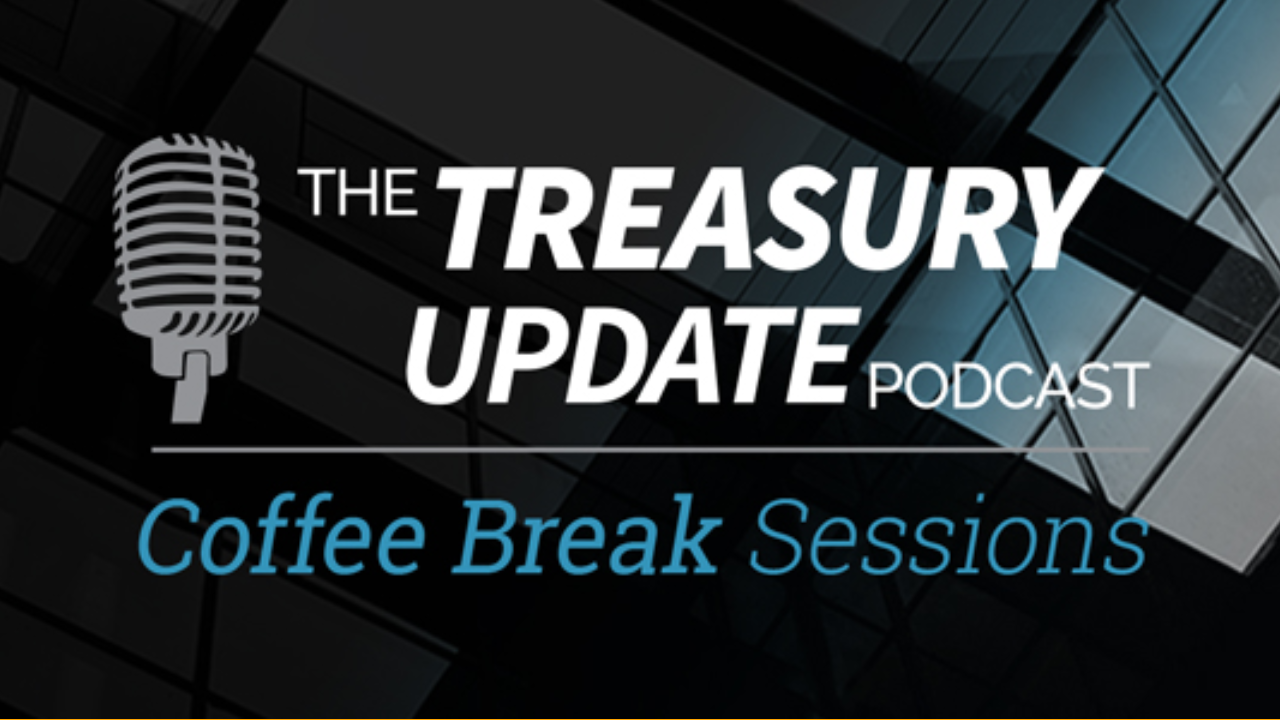
Session 11
What is Simple Treasury?
What is Simple Treasury? Coffee Break Session Host Alexa Cook speaks with Greg Parma, a Vice President of Finance, to discuss the foundational elements of simple treasury. They define the term and provide insightful recommendations on how to simplify a treasury. Tune in to this brief session to learn more.
To contact Greg about his services, visit his LinkedIn Page.
Host:
Alexa Cook, Strategic Treasurer
Speaker:
Greg Parma, VP of Finance
Episode Transcription - CBS Episode 11: What is Simple Treasury
Alexa Cook:
Hey guys, welcome to the Treasury Update Podcast, Coffee Break Session, the show where we cover foundational treasury topics and questions in about the same amount of time it takes you to drink your coffee.
Alexa Cook:
I’m joined today with Greg Parma, VP of finance, he’s got over a decade of finance and accounting experience ranging from an accountant through controller, to now VP of finance. So thanks for joining me, Greg, and welcome to the podcast.
Greg Parma:
Thanks Alexa. I’m happy to be here.
Alexa Cook:
So today we’re going to talk about … and I’m calling it simple treasury. I don’t know if that’s the best way to say it, but Greg, I understand in your work, you are setting things up for simplicity. So do you maybe want to expand on that a bit?
Greg Parma:
You know, focused on small and mid-sized businesses. The idea is to make treasury effective and not bogged down business and not over-complicate things unnecessarily. So, we focus on easy to execute solutions around treasury and to make it where it’s almost to a non-treasurer is easy to understand and execute.
Alexa Cook:
Gotcha, so it’s open for everyone to understand. What are the main objectives, I guess when you’re setting things up for simplicity? What are the focus points from a treasury perspective?
Greg Parma:
People follow the same key fundamentals for treasury. So you’re always worried about liquidity, funding and risk. So really it’s about making sure the business understands one, where you’re at in terms of funding. So if you’re in a burn position, or even if you’re profitable and cashflow positive, at least you have an idea of where you are with cash. Also, as well is liquidity, in terms of receivables versus some investments, that maybe held or definitely cash position against your liabilities, and then understanding business risk and calling those things out to be very clear in the process.
Alexa Cook:
Maybe we should take a step back because I know you’ve predominantly work with companies that are really in a growth phase. So I think as companies are growing, maybe treasury’s not a focus point or a strength for them. So maybe things get a little muddy and you’re basically saying you come in and you help them identify the three main points, which is liquidity, funding and risk. Then you’re just tearing things down a bit to make them simpler for even people outside of the treasury to understand.
Greg Parma:
That’s right. I’ll give a couple of practical examples. So a lot of times what we’ll see is, are you banking with the right people? The right individuals and organizations that understand your business? Do you have four different banks? How many accounts do you have? Let’s make that simple. Maybe there’s an account that takes money in, an account that lets money out and another holding account that draws interest. So those are some of the examples for small businesses that we like to look at and like to offer us solutions for these processes.
Greg Parma:
On top of that, to expand a little bit more, obviously cash forecasting and cash management are key. A lot of small businesses we’ll see just basically run the business on cash in the bank and not be looking forward enough to see what those risks are. So, that’s a simple cash forecast goes a long way, but in that forecast, that’s where we’ll call out risks or things that are going to happen in the next weeks or months. So you can plan better and look at where you’re at from a liquidity position, as well, as well as any significant happenings in the business.
Greg Parma:
This doesn’t have to be some complex model with a lot of moving pieces. We really want to make sure that business owners, business managers and directors can understand the positions of the company at a time and be able to make decisions.
Alexa Cook:
We’re trying not to over-complicate the three main pillars, which are liquidity, funding and risk. At the highest level, the focus is really going to be on those banking relationships. I mean, even on a broader scale, it could just be all of the vendor relationships. You don’t need a hundred different vendors or relationships. You just really need to focus on those key players. Then from that, you can dive down deeper and start a more of a long-term forecast. So whether that’s cash forecasting, or just more of the week to week cash management and expanding that on a look, that’s more than just what’s in the bank.
Greg Parma:
Yeah, start small. Oftentimes we see where small businesses may have some foreign operation and they try to hedge, or they’re trying to do some currency exchange to hedge the market, or to hedge receivables in another position. We say, “Hey, that’s glamorous, but it oftentimes adds so much time to manage that.” To continue on that point. We also see a lot of small businesses make investments in … they’re trying to take positions in the market. If you’re not dealing with hundreds of thousands or millions of dollars, it’s also a signal to your employees that you may care more about those investments than the business itself. It’s important to have even the implied decisions, even though it may not seem that way.
Greg Parma:
It takes away from what what the core values of the business are and how to provide value to the customer. So that’s really why we focus on simplicity, is because these things don’t give direct value to another dollar of cashflow, or free cashflow coming into the business through core services or products.
Alexa Cook:
All right. Well, I feel like I’ve already regrouped it a couple of times, but is there anything else you wanted to add on simple treasuries or how to keep things simple?
Greg Parma:
Yeah. Across the board, I think everyone should take stock of their business processes or even finance processes and make sure that you have one merchant service account, as long as you get the solution you need. Try to have one major banking relationship unless there’s a strategic reason to have another one. So to take stock of each piece of these actions and reprocess or realign the things that are pulling away from operations of the business, or strategic objectives driven by … whether it’s a single owner and this is what you want to do, or a board where there’s larger directives involved.
Alexa Cook:
Gotcha. That covers everything on simple treasury or how to keep things simple. So thank you, Greg, for joining me today and to our listeners, if you want to tune back in every first and third Thursday of the month, we’ll have a new podcast. As always, you can reach out to me at podcast@strategictreasurer.com and we will link some information about Greg and Greg’s services in our bio for this recording. So, check him out too. Thanks Greg.
Greg Parma:
Thanks Alexa.
OUTRO:
This podcast is provided for informational purposes only and statements made by Strategic Treasurer, LLC on this podcast are not intended as legal, business, consulting, or tax advice. For more information, visit and bookmark strategictreasurer.com.
Related Resources
Want access to more great content? Subscribe to Strategic Treasurer on YouTube!
A part of the Treasury Update Podcast, Coffee Break Sessions are 6-12 minute bite-size episodes covering foundational topics and core treasury issues in about the same amount of time it takes you to drink your coffee. The show episodes are released every first and third Thursday of the month with Special Host and Treasury Consultant Alexa Cook of Strategic Treasurer.




